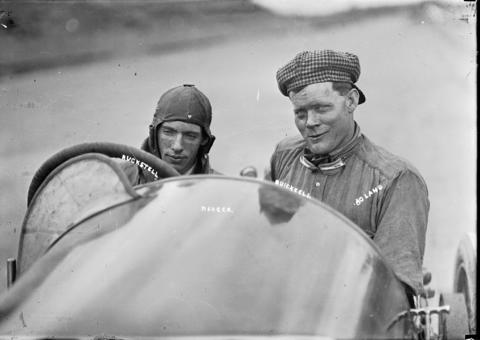Identity elements
Reference code
Name and location of repository
Level of description
Item
Title
BOLAND SPEEDWAY-068
Date(s)
- 1914-07 (Creation)
Extent
Name of creator
Content and structure elements
Scope and content
Race car driver Grover Ruckstell and his mechanic "Quicksell" after the pair came in second at the July 4, 1914 Montamarathon driving the #16 yellow Mercer. Winner and defending champion Earl Cooper picked up $2500 for his efforts while G.E. Ruckstell (often misspelled Ruckstall in the newspapers) received $1500 for second place. New to Tacoma, he was a teammate of Eddie Pullen and a driver of Californian George R. Bentel's Mercer cars. Mr. Ruckstell was also a mechanic and engineer, having earned his masters degree in automotive engineering from Princeton University. He also served as head of the famous Mercer racing team. He is also credited with developing the basic concept of a two speed rear axle into a popular product, the "Ruckstell Axle" marketed for Ford. The handcrafted Mercer was only manufactured for 15 years, but the Mercer Raceabout is considered the model sportscar of the era, the perfect blend of speed and finesse. The Mercer Auto Co. was incorporated in 1909, backed by the funds of millionaire businessmen Ferdinand Roebling and John Kruser. The automotive designs of Finley Robertson Porter and the business acumen of general manager and society playboy Washington Roebling II made the $1950 sports car the choice of wealthy sportsmen. The company reached its glory in 1914 and due to a series of bad turns was gone in a decade. The last Mercer was made in 1925. (T.Tribune 7/5/1914, pg. 1-results; www.chaffinsgarage.com; www.capitalcentury.com)
Tacoma Speedway (Lakewood); Racetracks--Lakewood--1910-1920; Automobile racing--Lakewood--1910-1920; Racing automobiles--1910-1920; Ruckstell, Grover; Mercer automobile; Automobile racing drivers;

